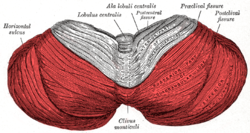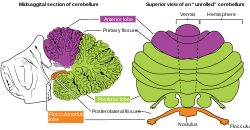| Posterior lobe of cerebellum | |
|---|---|
 Superior view of an cerebellum. Posterior lobe shown in red. | |
 | |
| Details | |
| Identifiers | |
| Latin | lobus posterior cerebelli |
| NeuroNames | 660 |
| NeuroLex ID | birnlex_911 |
| TA98 | A14.1.07.201 |
| TA2 | 5795 |
| FMA | 72252 |
| Anatomical terms of neuroanatomy | |
The posterior lobe of cerebellum or neocerebellum is one of the lobes of the cerebellum, below the primary fissure. The posterior lobe is much larger than anterior lobe. The anterior lobe is separated from the posterior lobe by the primary fissure, and the posterolateral fissure separates flocculonodular lobe from the posterior lobe.[1]
Sometimes, the posterior lobe of cerebellum is called the neocerebellum[2] since phylogenetically it is the newest part of the cerebellum. It plays an important role in fine motor coordination, specifically in the inhibition of involuntary movement via inhibitory neurotransmitters, especially GABA.[2]
The posterior lobe receives input mainly from the brainstem (i.e., reticular formation and inferior olivary nucleus) and cerebral cortex.[3]
It also has activation linked to happiness.[4]
- ^ (Patestas & Gartner 2016, p. 87)
- ^ a b "The Cerebellum".
- ^ Siegel, Allan Siegel, Hreday N. Sapru; case histories written by Heidi E. (2011). Essential neuroscience (2nd ed.). Philadelphia: Wolters Kluwer Health/Lippincott Williams & Wilkins. p. 190. ISBN 978-0-7817-8383-5.
{{cite book}}: CS1 maint: multiple names: authors list (link) - ^ Schienle A, Scharmüller W (August 2013). "Cerebellar activity and connectivity during the experience of disgust and happiness". Neuroscience. 246: 375–81. doi:10.1016/j.neuroscience.2013.04.048. PMID 23639880. S2CID 12832980.